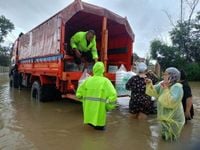As Southeast Asia reels from one of its most devastating flood seasons in recent history, the scale of destruction and human suffering across Indonesia, Thailand, Malaysia, and neighboring countries has left millions grappling with loss and uncertainty. The week leading up to Friday, November 28, 2025, saw relentless monsoon rains, rare cyclones, and tropical storms that have, according to Rappler, driven the regional death toll to at least 161, with many more missing or displaced. The disaster has sparked a massive, multinational rescue and relief effort, but for many, the ordeal is far from over.
In Indonesia, the island of Sumatra bore the brunt as flash floods and landslides swept through villages, submerging more than 2,000 homes and buildings. The National Disaster Management Agency reported that, by Thursday, November 27, at least 49 people had died and 67 were missing in North Sumatra province alone, according to the Associated Press. The situation worsened by Friday morning, with Rappler noting that the death toll on Sumatra had risen to 72. The devastation was compounded in the Padang Pariaman region, where 22 people perished and residents found themselves marooned on the upper floors of their homes, cut off from aid as floodwaters rose to a meter high.
“We’re running out of supplies and food,” said Muhammad Rais, a 40-year-old resident forced to move to the second floor of his house to escape the rising waters, as quoted by Rappler. Communications remained down in some areas, and authorities scrambled to restore power and clear roads blocked by landslide debris. The Indonesian government responded by airlifting aid and rescue personnel into the most affected zones, a daunting task given the extent of the damage and the ongoing risk of further downpours. The Meteorology, Climatology and Geophysics Agency warned that extreme rainfall would likely persist into early December, raising fears that the death toll could climb even higher.
To mitigate further calamity, Indonesia’s disaster agency chief Suharyanto announced the deployment of weather modification technology—cloud seeding—to redirect rainfall away from devastated areas. “We are deploying weather modification technology starting tomorrow so that rain does not fall during this emergency response period,” Suharyanto told reporters, as reported by the Associated Press. Rescue teams, meanwhile, worked tirelessly, often with little more than hand tools and their bare hands, to search for survivors and recover bodies amid thick mud and debris.
Elsewhere in Indonesia, the situation was equally dire. In Aceh province, nearly 47,000 people were displaced by floods, with about 1,500 forced into temporary shelters, the disaster agency said. Central Aceh alone saw at least nine deaths from landslides, and officials called for heavy machinery to help recover those still buried. In West Sumatra, six bodies were recovered from the Lumin Park area of Padang city, and over 3,300 houses were submerged in Padang Pariaman district. Rescuers continued the desperate search for 14 people believed to be buried under mud and rocks in the hilly Jorong Toboh village, while landslides cut off bridges and blocked main roads, isolating entire communities.
Across the Malacca Strait, Malaysia was hit by the remnants of tropical storm Senyar, which made landfall around midnight before November 28 and quickly weakened, according to Rappler. Even so, the storm left a trail of destruction: two people confirmed dead, more than 34,000 evacuated across eight states, and 7,000 displaced in Perlis state alone, as reported by BBC News. By Friday, about 30,000 evacuees remained in shelters. Malaysia’s foreign ministry reported that it had evacuated 1,459 nationals stranded in over 25 flood-hit hotels in neighboring Thailand, with plans to rescue the remaining 300 still trapped in flood zones.
Thailand faced its own catastrophe as floods swept through ten southern provinces, killing 87 people and affecting more than 3.5 million, according to a Thai government statement cited by Rappler. The city of Hat Yai, a crucial business hub near the Malaysian border, recorded an extraordinary 335 millimeters of rain in a single day on November 25—the heaviest downpour in 300 years, BBC News reported. The Thai military responded with a full-scale mobilization, deploying the aircraft carrier HTMS Chakri Naruebet, drones, helicopters, and convoys of trucks to deliver food, medicine, and rescue boats to survivors, many of whom were stranded on rooftops for days. The government also issued a public appeal for boats and jet skis to help reach those still trapped by floodwaters.
As the rain finally stopped in Hat Yai on Friday, residents found themselves ankle-deep in water, many without electricity, and facing the daunting task of salvaging what remained of their homes and businesses. “I’ve lost everything,” one resident told Rappler, capturing the sense of despair that pervaded the region.
The crisis was not confined to these three countries. Central Vietnam endured its worst floods in more than 50 years from November 16 to 21, with 108 people dead or missing and over 272,000 homes submerged, according to BBC News. The ancient city of Hue was completely inundated after a staggering 1,739 millimeters of rain fell in just 24 hours—the second highest daily rainfall ever recorded worldwide. The Perfume River, which flows through Hue, surged to a 60-year high, rising about five meters and transforming city streets into waterways.
The Philippines, too, suffered tremendous losses earlier in November, when Typhoon Kalmaegi left at least 188 dead and 135 missing, followed closely by Super Typhoon Fung-wong, which forced nearly a million people to evacuate and killed at least two, as detailed by BBC News.
Scientists and meteorologists agree that the spate of extreme weather events battering Southeast Asia is closely linked to climate change. Gianmarco Mengaldo, a researcher at the National University of Singapore, explained to Reuters, “Climate change enhances typhoon intensity primarily by warming ocean surface temperatures and increasing atmospheric moisture content. Although this does not imply that every typhoon will become stronger, the likelihood of powerful storms exhibiting greater intensity, with heavier precipitation and stronger winds, rises in a warmer climate.”
This year’s catastrophic floods and storms have exposed the region’s acute vulnerability to climate-driven disasters. With millions displaced, infrastructure crippled, and recovery efforts only just beginning, the monsoon season of 2025 may well be remembered as a stark warning of the new normal facing Southeast Asia. For those left picking up the pieces, the hope is that the lessons learned will spur greater resilience and preparedness in the face of an increasingly volatile climate.




